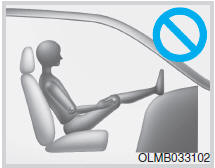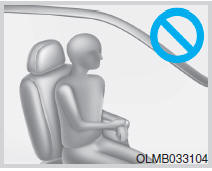Hyundai Tucson: Air bag - advanced supplemental restraint system / Occupant Classification System (OCS)

Your vehicle is equipped with an Occupant Classification System (OCS) in the front passenger's seat.
The OCS is designed to detect the presence of a properly-seated front passenger and determine if the passenger's front air bag should be enabled (may inflate) or not. The driver's front air bag is not affected or controlled by the OCS.
Main components of the Occupant Classification System
- A detection device located within the front passenger seat cushion.
- Electronic system to determine whether the passenger air bag systems (both front and side) should be activated or deactivated.
- An indicator light located on the instrument panel which illuminates the words "PASSENGER AIR BAG OFF" indicating the front passenger air bag system is deactivated.
- The instrument panel air bag indicator light is interconnected with the OCS.
Front passenger seat adult occupants who are properly seated and wearing the seat belt properly, should not cause the passenger air bag to be automatically turned OFF.
However, if the occupant does not sit in the seat properly (for example, by not sitting upright, by sitting on the edge of the seat, or by otherwise being out of position), this could cause the sensor to turn the air bag OFF.
You will find the "PASSENGER AIR BAG OFF" indicator on the center facia panel. This system detects the conditions 1-4 in the following table and activates or deactivates the front passenger air bag based on these conditions.
Always be sure that you and all vehicle occupants are seated properly and wearing the seat belt properly for the most effective protection by the air bag and the seat belt.
The OCS may not function properly if the passenger takes actions which can affect the classification system. These include:
- Failing to sit in an upright position.
- Leaning against the door or center console.
- Sitting towards the sides of the front of the seat.
- Putting their legs on the dashboard or resting them on other locations which reduce the passenger weight on the front seat.
- Wearing the seat belt improperly.
- Reclining the seatback.
Condition and operation in the front passenger Occupant Classification System

*1 The system judges a person of adult size as an adult. When a smaller adult sits in the front passenger seat, the system may recognize him/her as a child depending on his/her physique and posture.
*2 Do not allow children to ride in the front passenger seat. When a larger child who has outgrown a child restraint system sits in the front passenger seat, the system may recognize him/her as an adult depending upon his/her physique or sitting position.
*3 Never install a child restraint system on the front passenger seat.
WARNING
Riding in an improper position or placing weight on the front passenger's seat when it is unoccupied by a passenger adversely affects the OCS. To reduce the risk of serious injury or death:

- NEVER put a heavy load in the front seat or seatback pocket.

- NEVER place your feet on the front passenger seatback.

- NEVER sit with your hips shifted towards the front of the seat.

- NEVER ride with the seatback reclined when the vehicle is moving.

- NEVER place your feet or legs on the dashboard.

- NEVER lean on the door or center console or sit on one side of the front passenger seat.

Proper seated position for OCS
If the “PASSENGER AIR BAG OFF” indicator is on when an adult is seated in the front passenger seat, place the ignition switch to the LOCK/OFF position and ask the passenger to sit properly (sitting upright with the seat back in an upright position, centered on the seat cushion with their seat belt on, legs comfortably extended and their feet on the floor). Restart the engine and have the person remain in that position. This will allow the system to detect the person and to enable the passenger air bag. If the "PASSENGER AIR BAG OFF" indicator is still on, ask the passenger to move to the rear seat.
WARNING
Never allow an adult passenger to ride in the front passenger seat when the “PASSENGER AIR BAG OFF” indicator is illuminated. During a collision, the air bag will not inflate if the indicator is illuminated. Have your passenger move to the rear seat.
âś˝ NOTICE
The "PASSENGER AIR BAG OFF" indicator illuminates for approximately 4 seconds after the ignition switch is in the ON position or after the engine is started. If the front passenger seat is occupied, the OCS will then classify the front passenger after several more seconds.
Do Not Install a Child Restraint in the Front Passenger’s Seat

Even though your vehicle is equipped with the OCS, never install a child restraint in the front passenger’s seat.
An inflating air bag can forcefully strike a child or restraint resulting in serious or fatal injury.
WARNING
- NEVER place a rear-facing or front-facing child restraint in the front passenger’s seat of the vehicle.
- An inflating frontal air bag could forcefully strike a child resulting in serious injury or death.
- Always properly restrain children in an appropriate child restraint in the rear seat of the vehicle.
 What to expect after an air bag inflates
What to expect after an air bag inflates
After a frontal or side air bag inflates, it will deflate very quickly. Air bag
inflation will not prevent the driver from seeing out of the windshield or being
able to steer. Curtain air bags may ...
 Why Didn’t My Air Bag Go Off in a Collision? (Air bags are not designed to inflate
in every collision.)
Why Didn’t My Air Bag Go Off in a Collision? (Air bags are not designed to inflate
in every collision.)
There are certain types of accidents in which the air bag would not be expected
to provide additional protection.
These include rear impacts, second or third collisions in multiple impact accidents ...
Other information:
Hyundai Tucson (LM) 2010-2015 Owners Manual: Tire rotation
To equalize tread wear, HYUNDAI recommends that the tires be rotated every 7,500
miles (12,000 km) or sooner if irregular wear develops. During rotation, check the
tires for correct balance.
When rotating tires, check for uneven wear and damage. Abnormal wear is usually
caused by incorrect ti ...
Hyundai Tucson (LM) 2010-2015 Service Manual: 26 Brake Control Solenoid Valve(26/B_VFS) Repair procedures
Inspection
1.
Turn ignition switch OFF.
2.
Disconnect the solenoid valve connector.
3.
Measure resistance between sensor signal terminal and sensor ground terminal.
4.
Check that the resistance is within the specification.
Removal
Replacing an on/off soleno ...
